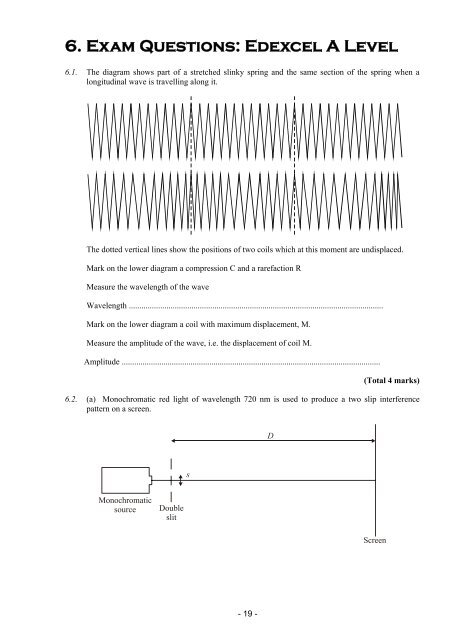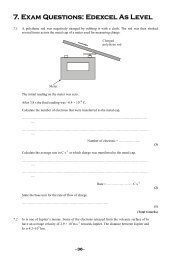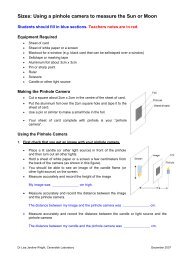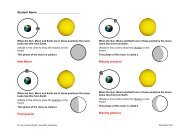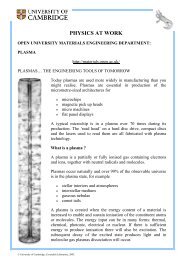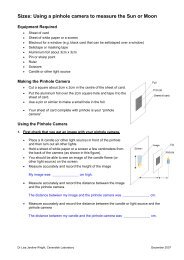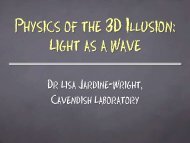6. Exam Questions: Edexcel A Level
6. Exam Questions: Edexcel A Level
6. Exam Questions: Edexcel A Level
Create successful ePaper yourself
Turn your PDF publications into a flip-book with our unique Google optimized e-Paper software.
<strong>6.</strong> <strong>Exam</strong> <strong>Questions</strong>: <strong>Edexcel</strong> A <strong>Level</strong><strong>6.</strong><strong>6.</strong>1. The diagram shows part of a stretched slinky spring and the same section of the spring when alongitudinal wave is travelling along it.The dotted vertical lines show the positions of two coils which at this moment are undisplaced.Mark on the lower diagram a compression C and a rarefaction RMeasure the wavelength of the waveWavelength ..........................................................................................................................Mark on the lower diagram a coil with maximum displacement, M.Measure the amplitude of the wave, i.e. the displacement of coil M.<strong>6.</strong> Amplitude ............................................................................................................................(Total 4 marks)<strong>6.</strong>2. (a) Monochromatic red light of wavelength 720 nm is used to produce a two slip interferencepattern on a screen.DsMonochromaticsourceDoubleslitScreen- 19 -
(i)Give typical values for the slit separation s and the distance D between the double slitand screen.s .......................................................................................................................D .......................................................................................................................(2)(ii)A drawing of the central section of the interference pattern is shown on the grid below.The centre of the pattern is at O.Centre of patternORedfringesSCALE1 cmrepresents5 mmDetermine a value for the separation of the red fringes. Show your working..................................................................................................................................................................................................................................................................................................................................................................................Fringe separation = ..........................................(3)- 20 -
(b)The red source is replaced by a monochromatic blue source of wavelength 480 nm toproduce a second interference pattern. The practical arrangement remains unchanged.Use the lower part of the grid to draw the five central blue fringes. Use the lines below forany calculation you make..........................................................................................................................................................................................................................................................................................................................................................................................................................................................................................................................................................................................................................................................................................(3)(c)Describe the appearance of the central fringe formed at O when a white light source is used................................................................................................................................................................................................................................................................................................................................................................................................................(2)(Total 10 marks)<strong>6.</strong>3. The diagram below shows a loudspeaker which sends a note of constant frequency towards avertical metal sheet. As the microphone is moved between the loudspeaker and the metal sheet theamplitude of the vertical trace on the oscilloscope continually changes several times betweenmaximum and minimum values. This shows that a stationary wave has been set up in the spacebetween the loudspeaker and the metal sheet.LoudspeakerMicrophoneMetalsheetSignalgeneratorTo oscilloscope(time base off)How has the stationary wave been produced?..........................................................................................................................................................................................................................................................................................................................................................................................................................................State how the stationary wave pattern changes when the frequency of the signal generator isdoubled. Explain your answer...............................................................................................................................................(2)..............................................................................................................................................- 21 -(2)
What measurements would you take, and how would you use them, to calculate the speed of soundin air?......................................................................................................................................................................................................................................................................................................................................................................................................................................................................................................................................................................................................................................................................................................................................(4)Suggest why the minima detected near the sheet are much smaller than those detected nearthe loudspeaker...........................................................................................................................................................................................................................................................................................................................................................................................................................................(2)(Total 10 marks)<strong>6.</strong>4. (a) A student is given a ripple tank in which plane waves can be generated.Outline how the student could measure the wave speed v, the frequency f and the wavelength of the waves...………………………………………………………………………………………..………………………………………………………………………………………..………………………………………………………………………………………..………………………………………………………………………………………..………………………………………………………………………………………(6)(b)The speed of ocean waves in deep water is given by the relationship g2where g is the acceleration of free fall and is the wavelength of the waves.Derive an expression for T, the period of the waves, in terms of g and ...………………………………………………………………………………………..………………………………………………………………………………………..………………………………………………………………………………………(3)- 22 -
Calculate the value of T when the wavelength of the waves is 8.0 m...………………………………………………………………………………………..………………………………………………………………………………………T = …………………………………………………(1)(Total 10 marks)<strong>6.</strong>5. Complete the diagram below to show the different regions of the electromagnetic spectrum.Radio waves(2)State four differences between radio waves and sound waves.1. ……………………………………………………………………………………………2. ……………………………………………………………………………………………3. ……………………………………………………………………………………………4. ……………………………………………………………………………………………(4)Two radio stations broadcast at frequencies of 198 kHz and 95.8 MHz. Which station broadcasts atthe longer wavelength?………………………………………………………………………………………………Why do obstacles such as buildings and hills present less of a problem for the reception of thesignal from the station transmitting at the longer wavelength?………………………………………………………………………………………………………………………………………………………………………………………………………………………………………………………………………………………………………………………………………………………………………………………………………………………………………………………………………………………………………………………………………………………………………………………………(3)(Total 9 marks)- 23 -
<strong>6.</strong><strong>6.</strong> Sound travels by means of longitudinal waves in air and solids. A progressive sound wave ofwavelength and frequency f passes through a solid from left to right. The diagram × belowrepresents the equilibrium position of a line of atoms in the solid.Diagram Y represents the positions of the same atoms at a time t = t 0 .XYt oZ t = t + T o4Explain why the wave is longitudinal.............................................................................................................................................................................................................................................................................................(1)On diagram Y label(i)(ii)(iii)two compressions (C),two rare factions (R),the wavelength of the wave.(3)The period of the wave is T. Give a relationship between , T and the speed of the wave inthe solid.............................................................................................................................................................................................................................................................................................(1)Along the line Z mark in the positions of the two compressions and the two rare factions at atime t given by t = t 0 + T/4.(2)(Total 7 marks))Total /50- 24 -
MARK SCHEME<strong>6.</strong>1.M M MRCRCOne of compression C and one rarefaction R marked as above.Wavelength of wave = 11 - 11.6 cm (u.e.)One of maximum displacement M marked as above [M, 5 th , 6 th , 7 th ].Amplitude of wave = 8 ( 1 mm) [consequent mark][Total 4 marks]<strong>6.</strong>2. (a) (i) Typical valuesSlit separation: 0.1 to 1.0 mm (1)Distance: 0.5 to 10 m (1) (2)(ii)Fringe separationCorrect measurement to give separation on grid (1)i.e. 12 mm, or correct distance across stated number of fringesUse of scale (1)6 mm [Only award if first mark gained] (1) (3)OR (if they think “separation” means half x)Correct measurement to give separation on grid (1)i.e. 6 mm, or correct distance across stated number of fringesUse of scale (1)[2 marks max]OR (if they use formula)Use of = xs/D (1)[See 720 for , and any values for (D, s) except (9.6, 6)][1 mark max][No marks for using measurements off the apparatus diagram](b)(c)Blue Fringes5 equally spaced fringes centred at O [Ignore additional fringes] (1)Fringe centres 8 mm apart on grid (1)Bands and gaps equal width (1) (3)[Mark all points on diagram, ignoring working.][No marks if fringe pattern drawn is identical to the red one]Central fringeWhite centre (1)Red edge(s) / red furthest from centre (1) (2)[Total 10 marks]- 25 -
<strong>6.</strong>3. The diagram below shows a loudspeaker which sends a note of constant frequency towards avertical metal sheet. As the microphone is moved between the loudspeaker and the metal sheet theamplitude of the vertical trace on the oscilloscope continually changes several times betweenmaximum and minimum values. This shows that a stationary wave has been set up in the spacebetween the loudspeaker and the metal sheet.LoudspeakerMicrophoneMetalsheetSignalgeneratorTo oscilloscope(time base off)How has the stationary wave been produced?by superposition/interference (1)with a reflected wave/wave of same speed and wavelength in opposite direction (1)(2)State how the stationary wave pattern changes when the frequency of the signal generator isdoubled. Explain your answer.Maxima/nodes/equivalent are closer together (1)since wavelength is halved (1)(2)What measurements would you take, and how would you use them, to calculate the speed of soundin air?Measure distance between minima/equivalent (1)Repeat/take average (1)Method of finding frequency (1) = 2 × (node – node)/equivalent (1)V = f × (1)(Four marks maximum)Other methods eligible for full marks.Suggest why the minima detected near the sheet are much smaller than those detected near theloudspeaker.Near the sheet there is almost complete cancellation (1)since incident and reflected waves are of almost equal amplitude (1)(4)(2 marks)[Total 10 marks]- 26 -
<strong>6.</strong>4 Complete the diagram below to show the different regions of the electromagnetic spectrum.Radio waves IR Visible Uv X-ray -rayState four differences between radio waves and sound waves.1. Radio transverse; sound longitudinal. (1)2. Travels through vacuum; requires medium. (1)3. Radio travels at speed of light; sound travels much slower. (1)4. Can be polarised; cannot be polarised. (1)5. Radio electromagnetic; sound pressure. (1)Two radio stations broadcast at frequencies of 198 kHz and 95.8 MHz. Which stationbroadcasts at the longer wavelength?198 kHz (1)Why do obstacles such as buildings and hills present less of a problem for the reception ofthe signal from the station transmitting at the longer wavelength?Longer wavelength diffracts (1)and waves tend to go to receiver (1)(2)(MAX 4)(3)[Total 9 marks]<strong>6.</strong>5 Sound travels by means of longitudinal waves in air and solids. A progressive sound waveof wavelength and frequency f passes through a solid from left to right. The diagram Xbelow represents the equilibrium position of a line of atoms in the solid.Diagram Y represents the positions of the same atoms at a time t = t 0Explain why the wave is longitudinal.Vibrations/Oscillations of atoms is and wave / energy travels / along direction of / parallel to / equivalent(1)On diagram Y label(i)(ii)two compressions (C),Any two C’s within / . . . / (1)two rarefactions (R),Any two R’s anywhere inside (1)(iii)the wavelength of the wave.Any correct place (1)- 27 -(3)
The period of the wave is T. Give a relationship between , T and the speed of the wave inthe solid.Speed/symbol = T or T = or T = Along the line Z mark in the positions of the two compressions and the two rare factions at atime t given by t = t 0 + T/4.1st Mark: 2 C’s or 2 clusters moved ¼ their 2nd mark: To the right<strong>6.</strong>6 (a) A student is given a ripple tank in which plane waves can be generated.(1)(2)[Total 7 marks]Outline how the student could measure the wave speed v, the frequency f and the wavelength of the waves.Measurement of fUse of strobe OR Connect oscillator to cro (1)Vibrator appears stationary Reference to use of time base (1)Measurement of Measurement across several peaks (1)and average (1)Measurement of vTime at least 3 times a wave across tank (1)Use of v =distance across tanktime(b) The speed v of ocean waves in deep water is given by the relationship(1)(6) g2where g is the acceleration of free fall and is the wavelength of the waves.Derive an expression for T, the period of the waves, in terms of g and .v = f (1)sf (1)22T g(1)(3)Calculate the value of T when the wavelength of the waves is 8.0 m.T = 2.3 s (1)(1 marks)[Total 10 marks]- 28 -


